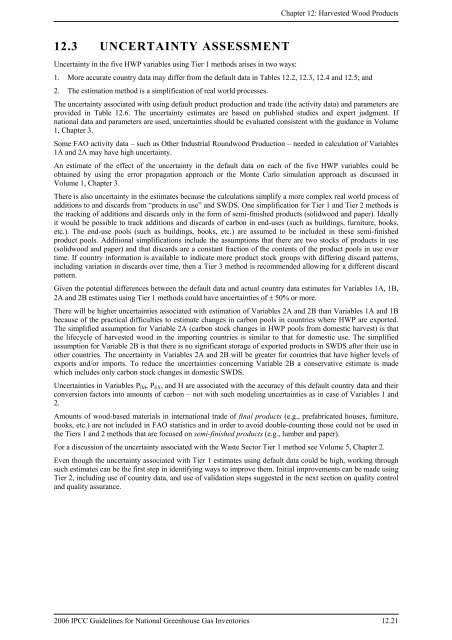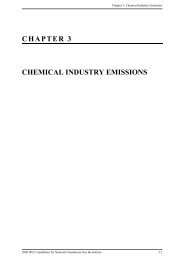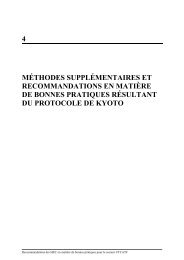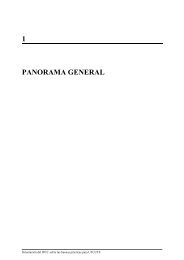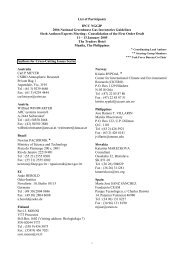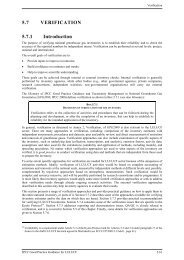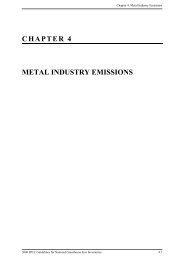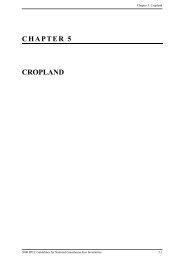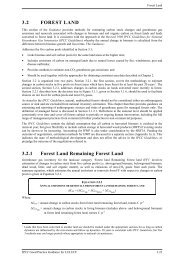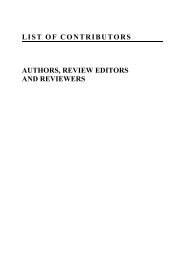chapter 12 harvested wood products - IPCC - Task Force on ...
chapter 12 harvested wood products - IPCC - Task Force on ...
chapter 12 harvested wood products - IPCC - Task Force on ...
Create successful ePaper yourself
Turn your PDF publications into a flip-book with our unique Google optimized e-Paper software.
Chapter <str<strong>on</strong>g>12</str<strong>on</strong>g>: Harvested Wood Products<br />
<str<strong>on</strong>g>12</str<strong>on</strong>g>.3 UNCERTAINTY ASSESSMENT<br />
Uncertainty in the five HWP variables using Tier 1 methods arises in two ways:<br />
1. More accurate country data may differ from the default data in Tables <str<strong>on</strong>g>12</str<strong>on</strong>g>.2, <str<strong>on</strong>g>12</str<strong>on</strong>g>.3, <str<strong>on</strong>g>12</str<strong>on</strong>g>.4 and <str<strong>on</strong>g>12</str<strong>on</strong>g>.5; and<br />
2. The estimati<strong>on</strong> method is a simplificati<strong>on</strong> of real world processes.<br />
The uncertainty associated with using default product producti<strong>on</strong> and trade (the activity data) and parameters are<br />
provided in Table <str<strong>on</strong>g>12</str<strong>on</strong>g>.6. The uncertainty estimates are based <strong>on</strong> published studies and expert judgment. If<br />
nati<strong>on</strong>al data and parameters are used, uncertainties should be evaluated c<strong>on</strong>sistent with the guidance in Volume<br />
1, Chapter 3.<br />
Some FAO activity data – such as Other Industrial Round<str<strong>on</strong>g>wood</str<strong>on</strong>g> Producti<strong>on</strong> – needed in calculati<strong>on</strong> of Variables<br />
1A and 2A may have high uncertainty.<br />
An estimate of the effect of the uncertainty in the default data <strong>on</strong> each of the five HWP variables could be<br />
obtained by using the error propagati<strong>on</strong> approach or the M<strong>on</strong>te Carlo simulati<strong>on</strong> approach as discussed in<br />
Volume 1, Chapter 3.<br />
There is also uncertainty in the estimates because the calculati<strong>on</strong>s simplify a more complex real world process of<br />
additi<strong>on</strong>s to and discards from “<str<strong>on</strong>g>products</str<strong>on</strong>g> in use” and SWDS. One simplificati<strong>on</strong> for Tier 1 and Tier 2 methods is<br />
the tracking of additi<strong>on</strong>s and discards <strong>on</strong>ly in the form of semi-finished <str<strong>on</strong>g>products</str<strong>on</strong>g> (solid<str<strong>on</strong>g>wood</str<strong>on</strong>g> and paper). Ideally<br />
it would be possible to track additi<strong>on</strong>s and discards of carb<strong>on</strong> in end-uses (such as buildings, furniture, books,<br />
etc.). The end-use pools (such as buildings, books, etc.) are assumed to be included in these semi-finished<br />
product pools. Additi<strong>on</strong>al simplificati<strong>on</strong>s include the assumpti<strong>on</strong>s that there are two stocks of <str<strong>on</strong>g>products</str<strong>on</strong>g> in use<br />
(solid<str<strong>on</strong>g>wood</str<strong>on</strong>g> and paper) and that discards are a c<strong>on</strong>stant fracti<strong>on</strong> of the c<strong>on</strong>tents of the product pools in use over<br />
time. If country informati<strong>on</strong> is available to indicate more product stock groups with differing discard patterns,<br />
including variati<strong>on</strong> in discards over time, then a Tier 3 method is recommended allowing for a different discard<br />
pattern.<br />
Given the potential differences between the default data and actual country data estimates for Variables 1A, 1B,<br />
2A and 2B estimates using Tier 1 methods could have uncertainties of ± 50% or more.<br />
There will be higher uncertainties associated with estimati<strong>on</strong> of Variables 2A and 2B than Variables 1A and 1B<br />
because of the practical difficulties to estimate changes in carb<strong>on</strong> pools in countries where HWP are exported.<br />
The simplified assumpti<strong>on</strong> for Variable 2A (carb<strong>on</strong> stock changes in HWP pools from domestic harvest) is that<br />
the lifecycle of <str<strong>on</strong>g>harvested</str<strong>on</strong>g> <str<strong>on</strong>g>wood</str<strong>on</strong>g> in the importing countries is similar to that for domestic use. The simplified<br />
assumpti<strong>on</strong> for Variable 2B is that there is no significant storage of exported <str<strong>on</strong>g>products</str<strong>on</strong>g> in SWDS after their use in<br />
other countries. The uncertainty in Variables 2A and 2B will be greater for countries that have higher levels of<br />
exports and/or imports. To reduce the uncertainties c<strong>on</strong>cerning Variable 2B a c<strong>on</strong>servative estimate is made<br />
which includes <strong>on</strong>ly carb<strong>on</strong> stock changes in domestic SWDS.<br />
Uncertainties in Variables P IM , P EX , and H are associated with the accuracy of this default country data and their<br />
c<strong>on</strong>versi<strong>on</strong> factors into amounts of carb<strong>on</strong> − not with such modeling uncertainties as in case of Variables 1 and<br />
2.<br />
Amounts of <str<strong>on</strong>g>wood</str<strong>on</strong>g>-based materials in internati<strong>on</strong>al trade of final <str<strong>on</strong>g>products</str<strong>on</strong>g> (e.g., prefabricated houses, furniture,<br />
books, etc.) are not included in FAO statistics and in order to avoid double-counting those could not be used in<br />
the Tiers 1 and 2 methods that are focused <strong>on</strong> semi-finished <str<strong>on</strong>g>products</str<strong>on</strong>g> (e.g., lumber and paper).<br />
For a discussi<strong>on</strong> of the uncertainty associated with the Waste Sector Tier 1 method see Volume 5, Chapter 2.<br />
Even though the uncertainty associated with Tier 1 estimates using default data could be high, working through<br />
such estimates can be the first step in identifying ways to improve them. Initial improvements can be made using<br />
Tier 2, including use of country data, and use of validati<strong>on</strong> steps suggested in the next secti<strong>on</strong> <strong>on</strong> quality c<strong>on</strong>trol<br />
and quality assurance.<br />
2006 <str<strong>on</strong>g>IPCC</str<strong>on</strong>g> Guidelines for Nati<strong>on</strong>al Greenhouse Gas Inventories <str<strong>on</strong>g>12</str<strong>on</strong>g>.21


